Talk with our local travel specialist who can help organize your trip.
How difficult is the Island peak climbing
Island Peak, known locally as Imja Tse (6,189m/ 20,305ft), is located in the mystic northeastern Himalayas of Nepal. Climbing the mighty Island peak is a remarkable feat and fascination that requires careful planning and preparation. While most of the Island peak climbing is considered moderate in terms of difficulty, the steep ascends, and the foot of the headwall crevasse is challenging. However, this challenge is what makes climbing the Island peak so memorable and exciting.
The name 'Island' comes from the fact that the peak is situated between a sea of ice, glaciers in the heart of Chhukung valley and looks no less than an island. The peak is dwarfed by the magnanimous Lhotse and Nuptse mountains to the north and Baruntse to the south, and it is an extension of the southern ridge of Lhotse.
The Island peak is a true wonder and has gained popularity among mountain lovers for a long time now. As written in history, the southern part of the peak was climbed as a training peak by the British expedition team and Tenzing Norgay Sherpa in 1953 before their renowned expedition to Everest. The expedition team was also responsible for coining it as Island Peak from their view of the peak from Dingboche village. The route discovered by them has been popularized ever since and even used to date. Those who want to climb Mt. Everest have followed the same pattern and prefer summiting the Imja Tse before conquering the tallest mountain in the world.
According to alpine standards, Island peak is a moderately difficult climbing peak that is best suited for novice climbers and nature lovers who are starting off their mountain climbing journey.
Table of Content
- How Do You Get To Island Peak?
- Highlights Of Island Peak Climbing
- Best Time To Climb Island Peak
- Weather Condition
- Clothing & Equipment
- Accommodations, Food And Drinking Water
- Island Peak Climbing Permit
- Preparations For Island Peak Climb
- Altitude Sickness
- Travel Insurance And Emergency Evacuation for Island Peak
- Can I Climb Island Peak?
- Tips For Climbing Island Peak
- Conclusion
How Do You Get To Island Peak?

Getting to Island Peak is not as easy as it takes many days of trekking along the cold Khumbu region. It is situated close to the border of Nepal and Tibet in the Khumbu range of mountains. The entire expedition takes about 14 days traversing from one village to the other before reaching the base camp then the summit.
Kathmandu to Lukla
Your journey begins from the domestic airport in Kathmandu, Nepal, from where you take a flight northeast to Tenzing Hillary Airport in Lukla, the only gateway to the Khumbu region. The flight takes about 40 minutes, offering a bird's eye view of the mountains and glaciers.
Lukla to Chukkung
From Lukla, trekking begins towards Chukkung, which is closest to Island Peak. Along the way, you enter the Sagarmatha National Park gateway. Make stops at Namche Bazaar, the commercial and tourist hub of Khumbu, then to Tengboche and visit the largest monastery of Khumbu, then to Dingboche. The first views of Imja Tse can be seen from Dingboche village.
Some tourists prefer to take a detour to the Everest Base Camp by heading further north to Lobuche and join the island peak trail in Chukkung by crossing the high pass of Kongma La (5,535m). However, this is entirely optional and would take an extra 4 to 5 days.
If you are not planning to take the detour to Everest Base Camp, then from Dingboche, you can head straight east to Chukkung, which takes a day or two.
Trek to Island Peak Base Camp
Inching closer to the peak, you will leave Chukkung and head to the base camp below the southern flank of the Lhotse glacier. Passing the Imka and Lhotse glacier, you reach the Island Base Camp/ Pareshaya Gyab for pre-climbing training.
Summit Island Peak
You can either start climbing from the base camp itself or hike up to the High Camp, then begin the climb to reduce the effort and time needed for summit day. However, that would also depend on the itinerary planned out. The climb starts from early morning with an initial steep climb to High camp then Crampon Point from where your crampons will come to use in the icy landscape. Following a ridge to the base of the Imja glacier, you begin the climb using ladders to cross crevasses to the summit. Finally, you get to Island Peak after a challenging upgrade which is a humbling feeling as you are towered by the gigantic south face of Lhotse.
Highlights Of Island Peak Climbing
- Experience submitting 6,189m/ 20,305ft technical peak crossing crevasses, climbing ice walls, and passing glaciers
- Views of the eight-thousander mountains like Lhotse, Everest, Cho Oyu, and Manaslu from the summit
- Witness the varied aesthetic alpine and unique wilderness in the Sagarmatha National Park
- Make stops at the different villages along the Dudh Koshi and Chukung valley on the way to the summit and experience the way of life of the local Sherpa community.
- Interact with the locals and experience their unique Tibetan Buddhist religion, traditions, and culture
- Traverse the Imja river, Khumbu range of mountains, Imja Glacier, Lhotse Glacier, and some high passes on the way
Best Time To Climb Island Peak
The best time to climb Island Peak is in the spring and autumn season. While spring starts from March and lasts till May, Autumn runs from Mid September to November. April, May, Mid September, and October are the best months for Island peak climbing.
From the flight to Lukla right up to the summit, you will have a chance to view the high-standing Himalayas of Khumbu as the sky is clear with barely any rainy or misty clouds during this time. Wilderness of the Sagarmatha National Park are also at their best during this time. However, as these are the peak seasons, the trail can be crowded with people looking to go to Everest Base Camp or Island Peak.
The winter season from December to February is chilly, and the trail is covered with heaps of snow, making it difficult to traverse in the high icy face. Slipping on the steep snowy trail can be an added hassle during the climb. On the other hand, the monsoon season from June to August brings about heavy rains in the lower regions up until Namche Bazaar. Also, in higher altitudes, there may be misty clouds with unclear views. Some of the tea houses also shut their service during these seasons due to extreme weather. Hence, winter and monsoon seasons are regarded as off-seasons to avoid the additional challenges of climbing.
Preplanning the time to travel is crucial while thinking of taking a climbing expedition to the mountains of Nepal because the weather in higher altitudes is fluctuating.
Featured Trips
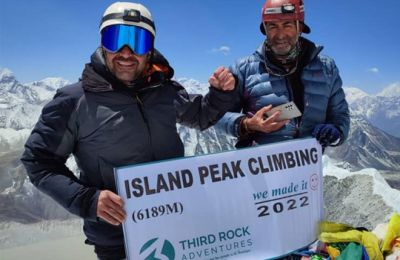
Island Peak Climbing - 15 days
Island Peak Climbing takes you to Nepal’s popular peak in the Everest region. Loved by novice as well as experienced climbers, the mountain offers you the ideal conditions to hone your climbing skills.
Inquire Now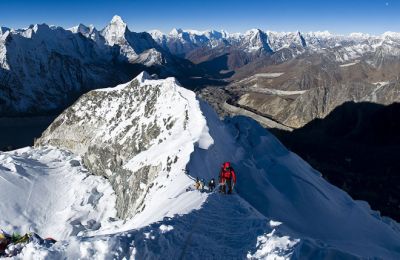
Island Peak Expedition from Chhukung - 5 days
Island Peak Expedition from Chhukung 4 days lets you climb Island Peak on a shoestring budget and pay only for the climbing portion. Trek independently and arrive at Chhukung, the starting point of your adventure.
Inquire NowWhere to travel next?
Get help from our travel specialists for holiday ideas that matches your interests.
Weather Condition
The weather condition in the high altitudes of Nepal changes rapidly, at times unpredictably. There have been times during the crazy weather that have proven to be fatal in the Khumbu region. Weather conditions in Imja Tse are no less different, so it is better to understand the difficulties that it might bring along.
During the spring and autumn season, the temperature is anywhere between 0 degrees Celsius to 15 degrees celsius making it the perfect time to climb. The nights and the early mornings are chilly where the temperature falls below 0. However, as the sun rises in the day, it gets warmer.
During the winter season, the temperature can go anywhere from 0 degrees celsius to -15 degrees celsius. The nights and mornings are also freezing, and you might have to add on some extra clothing layers to combat the extreme cold. In the monsoon season, there is a possibility of heavy rainfall at a lower altitude, so landslides and foggy visibility are possible. Snowstorms are inevitable during the winter and monsoon season at higher altitudes.
Clothing & Equipment

Planning your climbing trip means preparing the correct packing list, which includes clothing and equipment that fit the weather and terrain conditions in the mountains. As climbing peaks is a strenuous outdoor activity, taking the precise gears along with you is crucial.
Hence following are some of the clothing & equipment to be carried along to avoid additional difficulties in your Island peak climbing trip.
Clothing
Upper body: Windproof/waterproof light jacket, fleece jumper or jacket, Inner thermals, underwear, 3-4 T-shirts, down jacket
Lower body: Hardshell trouser, trekking pants, and waterproof trouser
Shoes: Sturdy trekking boots with ankle support, 5 to 6 pairs of thick socks, flip flops or sandals to wear inside the tea houses, gaiters to protect shoes and lower legs
Head: UV protection sunglasses, Sun Hat or cap, woolen cap, balaclava, and scarf
Hand: Insulated mountaineering mittens and inner gloves
Bags, gears, and accessories
You carry a 40L daypack with a waterproof cover, while the porter will carry an 80L duffel bag. Carry a five seasons sleeping bag with liner, headlamp, power bank, camera, and extra batteries. Carry personal health care items, sunscreen, and a medical kit.
Mountaineering Equipment
Carry climbing boots that are insulated with stiff soles and perfect for high-altitude climbing. Carry crampons, climbing helmet, Ice Axe with a strap, two lockable and two unlockable carabiners, Prussiks, Harnesses, Jumar/ascending device, Belay/descender device, and Tape Sling. Many travel agencies arrange the climbing equipment within the climbing trip package.
You can buy or hire most of the climbing gear, some heavy clothing, and bags from a rental shop in Kathmandu, Namche Bazaar, or Chhukung. It will save money and reduce the hassle of carrying extra loads on international and domestic flights. Also, you can leave some of the used and non-essential clothing and gear at your hotel or tea house room to pick it up along the way when you return on the same route. It is entirely safe, free of charge, and also reduces the hassle of carrying non-essential items.
Accommodations, Food And Drinking Water
Island Peak climbing involves staying at tea houses as well as tents in different regions of the route. In Kathmandu, the accommodation can be settled at a 3 to 5-star hotel depending upon your budget and preferred standard. These hotels have basic to luxurious settings, including furniture, hot water, TV, and more. From Lukla on to Chhukung, this is a tea house trekking experience. The locals own tea houses that have only the bare necessities, including a bed, mattress, and warm blanket. As the altitude keeps rising, the availability of decent rooms diminishes. During peak seasons, you might have to stay in bunk beds, and in worst cases, you might have to remain in dining halls that are cleared and prepared to sleep at night. There is the availability of hot water, but it is to be paid for additionally as the geysers run on gas that is tough to find in the higher altitudes. You will only find communal bathrooms that mostly have square seating. In terms of difficulty in accommodation, you will have to be very adaptable and accommodating of the setting as it is. The Internet is available in Tengboche and some Dingboche tea houses, but it takes ages to get a good signal. From Chukkung onwards, you will be staying at tented camps in the base camp and high camp. The tent is set up by the assistant who comes with you along the trip.
Food, on the other hand, is pretty decent at a higher altitude. As it is a tourist area, up until Chhukung, you can order from a small variety of dishes in the tea houses. Of course, there are options of eating pancakes, pizza, dumplings, and western breakfast. However, it is highly suggested that you eat as the locals eat when you go to these places. The staple food of lentils, rice, and vegetables is a highly sought-after meal, keeps you full and energetic, and is very fresh.
On the other hand, in the tented camp, food is cooked by the assistants who carry all the required utensils. So there are no food options, except what is cooked. Carry some digestive pills if your bowel movement is not the best.
Drinking water is essential when trekking beyond 4 to 5 hours a day in high altitudes. Dehydration can be pretty common, so fluid intake should be increased. You can buy bottled water, but it can be twofold costly in higher altitudes. Hence, you can carry a filtering flask or purification tablets along with a reusable water bottle and fill up water from different natural teams and taps you find along the route. Tea houses offer boiled drinking water but at an additional cost per liter or pot.
Island Peak Climbing Permit

Climbing in the Himalayas of Nepal requires a permit in addition to trekking in the Everest region. Imja Tse is classified in the Group B peaks, which requires a separate climbing permit. Following are the different permits that you would need to summit Island peak.
- Island peak Climbing Permit: This is a separate permit required by the Nepal Mountaineering Association (NMA), the cost of which depends on the season of travel. The fee is around USD 250 in spring, USD 125 in Autumn, and USD 70 in the off-seasons of Winter and Monsoon.
- Sagarmatha National Park Entry Permit: As you will be trekking on the premises of Sagarmatha National Park, you would require to show your permit in the Monjo gateway. It costs about USD 30 for foreign nationals and about USD 15 for SAARC nationals. There is also the Garbage Deposit Fee of USD 500 per expedition. It is refundable only after the team declarations the completion of garbage management properly for both recyclable and non-recyclable garbage after the climb.
- Khumbu Pasang Lhamu Rural Municipality Entrance permit: This local area permit can be collected at Lukla on arrival and costs around USD 20.
In addition, if you are willing to begin your trek from the Jiri route, you must also collect the Gaurishankar Conservation Area Project Entry Permit fee of NRS 2,000.
Individuals can acquire trekking permits; however, only government-registered trekking agencies can obtain the climbing permit. Also, the trekking agencies will take away the hassle of standing in queues and dealing with government officials to get the permit by managing it all by themselves.
Preparations For Island Peak Climb
Taking on the challenge of climbing the Island peak is not an easy task, mainly if this is your first peak climbing experience. Although the peak itself is nontechnical, some areas require some physical strength and careful consideration.
Physical fitness is a must when you take on this challenge as there is a lot of trekking involved. It is best if you make the decision six months before the actual peak climbing. This way, you will have time to prepare yourself physically and mentally for the climb. You need to have some previous trekking experience, even on an easy to moderate trail. Trekking at higher altitudes is also a great way to adapt to the diminishing oxygen level you will face in the Imja Tse summit.
To build up your stamina to walk, you will have to start exercising, cycling, hiking, or swimming 3 to 4 months in advance. It is also best to quit or minimize drinking alcohol and smoking before the days leading to climbing.
Preparing yourself for the climb also means doing some research on your own about the technicalities of the climb. You can learn about the mountaineering gears and some techniques beforehand, although the climbing leader will give real-life training before the actual summit day.
Altitude Sickness

Altitude sickness is a symptom shown when your body cannot adapt to the changes in high altitude with less oxygen in the air, and the air pressure starts increasing. It is always a risk in high-altitude trekking and peak climbing. As the maximum altitude of this peak climbing is 6,189m/ 20,305ft at the summit, mild to severe symptoms of AMS may be seen. The oxygen level can go from 88% up to as little as 43% during the trip. The mild symptoms include headache, fever, dizziness, and difficulty in breathing, and the severe form can range from fainting, vomiting up to the extreme case of heart failure.
Hence, it is crucial to maintain acclimatization by keeping some rest days in between the itinerary. A good Island Peak climbing itinerary will include acclimatization at Namche Bazaar, Chukkung, and maybe another at higher altitudes, and it helps the body to adapt to the change.
Another way to prepare yourself against altitude sickness is to take Diamox or any other tablet that keeps the symptoms at bay. It would be best to try to get a good night's sleep and rest after the day's trek is over. Keeping yourself hydrated at all times in high-altitude treks is also helpful.
However, if things don't seem right, you need to immediately inform your team, which will help you by taking you to the nearby hospital and or clinic available in Lukla and Namche.
Featured Trips
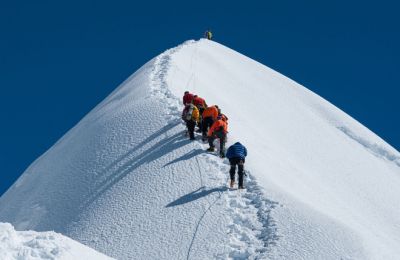
Island Peak Climbing with EBC Trek - 19 days
Island Peak Climbing and EBC Trek is for first-time climbers wishing for their first Himalayan summit. Hike to EBC and climb Island Peak safely within 19 days.
Inquire Now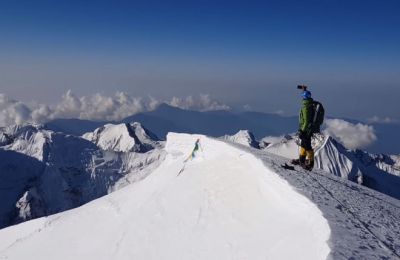
Mera Peak and Island Peak Climbing - 24 days
Mera Peak and Island Peak climbing is a trip to Nepal climb two peaks above 6000 meters in a single trip. Both Climbing adventure which lasts for 24 days will challenge you to the fullest.
Inquire NowWhere to travel next?
Get help from our travel specialists for holiday ideas that matches your interests.
Travel Insurance And Emergency Evacuation for Island Peak

Considering the difficulties that might arise in the Island Peak climbing adventure and any other climbing trip in Nepal, it is best to have suitable travel insurance. Ensure that the travel insurance policy you choose has an appropriate elevation coverage of over 6,189m/ 20,305ft. As this trip takes you on a flight to the mountainous region where flight cancellation is expected due to bad weather, make sure that the policy covers this. The treacherous trails and the occurrence of altitude sickness can expose you to possible dangers, which is why travel insurance is mandatory.
In case of any emergency like bad health, extreme altitude sickness, or any calamity, emergency helicopter evacuation is the most common way to deal with it. The helicopter will be managed in severe cases, and you will be flown to Lukla or back to Kathmandu, depending upon the situation. Most travel insurance also covers this contingency. However, these incidents are unusual, and if needed, your climbing team will get in touch with the nearest Himalayan Rescue Center below Chukkung.
Can I Climb Island Peak?
Island Peak climbing difficulty is classified as moderately difficult. The trip will take 14 to 19 days to complete depending upon the detours, of which only about a day or two is segregated for climbing. The maximum elevation of this climb is 6,189m/ 20,305ft at the summit.
On a day-to-day basis, there is an average of 4 to 6 hours of the trek on hills and challenging terrains. Passing the glaciers, rivers, rugged terrain, and mountain passes is another challenge as well. On the summit day itself, you will have to climb for 12 to 13 hours spanning a walking distance of about 10km. The weight of your heavy warm clothing and the 7 to 10 kgs of the backpack's weight adds to the challenge as well. These are some of the reasons why you need to be physically fit for summiting Island peak.
It is particularly suited for those trekking enthusiasts who want to begin their journey in mountain climbing. Experienced trekkers with a high level of the physique will find it moderately easy. You need to be confident in high-altitude trekking, even if you don't have previous climbing experience. Advanced knowledge of basic mountaineering skills is preferred but not mandatory as the team will give pre-climb training. If you have some pre-existing heart or lung disorder or have weakness of the knee, it is best first to consult your doctor to know whether you can do the climb.
If you are confident and have experience in high altitude trekking, are physically and mentally fit, then Island Peak climbing is best suited for you as your next big adventure.
Tips For Climbing Island Peak

We understand that planning and preparing for the most popular trekking peak in Nepal can be overwhelming, and hence we have come up with some highly recommended tips for climbing Island Peak.
- Learn about the basics of usage of mountaineering tools and technique beforehand and also practice multiple times with the gears and tools a day before the summit day
- Build up your stamina and flex your muscles by doing some exercising and training 2 to 3 months before the climb
- Buy high-quality climbing boots and practice walking in them because they are the most crucial clothing list.
- Avoid wearing cotton clothes during the trip as they take longer to dry, instead wear moisture-wicking merino wool or synthetic layers.
- Don't skip any day of acclimatization, as it is crucial to adapt to the depleting oxygen level to avoid altitude sickness.
- It is best to keep 1 to 2 days contingency/extra days while planning your itinerary because the chance of bad and unpredictable weather is high in the mountainous region of Nepal. If everything goes well, you can utilize the extra days by exploring Pokhara or Kathmandu.
- You can rent mountaineering gear, boots, and clothing in Kathmandu, Lukla, Namche, or Chhukung at a low cost to avoid substantial luggage expenses.
Recommended Read: Top 10 Tips To Summit Island Peak
Conclusion
Island Peak Climbing in Nepal is the best experience if you are an avid trekker looking to take the next step. Climbing the peak is challenging for novice trekkers, but it is not a technical climb, so anyone with the correct mindset, some trekking experience, and good physical fitness can try it. The adventure and triumph of having passed the rugged trail, cold climate, and submitted to the mighty peak are worth all the challenge. You can avoid specific difficulties of the climb by doing prior study and research. The above will help enthusiasts in deciding whether the Island peak climbing is for them or not.
If you feel that Island peak is best suited for you, you can get in touch with us to know more from our experts and start making plans for this big adventure.
Other Useful Links
Island Peak Expedition from Chhukung - 4 Days
Island Peak Climbing with EBC Trek - 19 Days
Mera Peak and Island Peak Climbing - 24 Days
Mera Peak vs Island Peak Climbing
- Written by: Naba Raj Amgai
Updated: Oct, 28, 2021

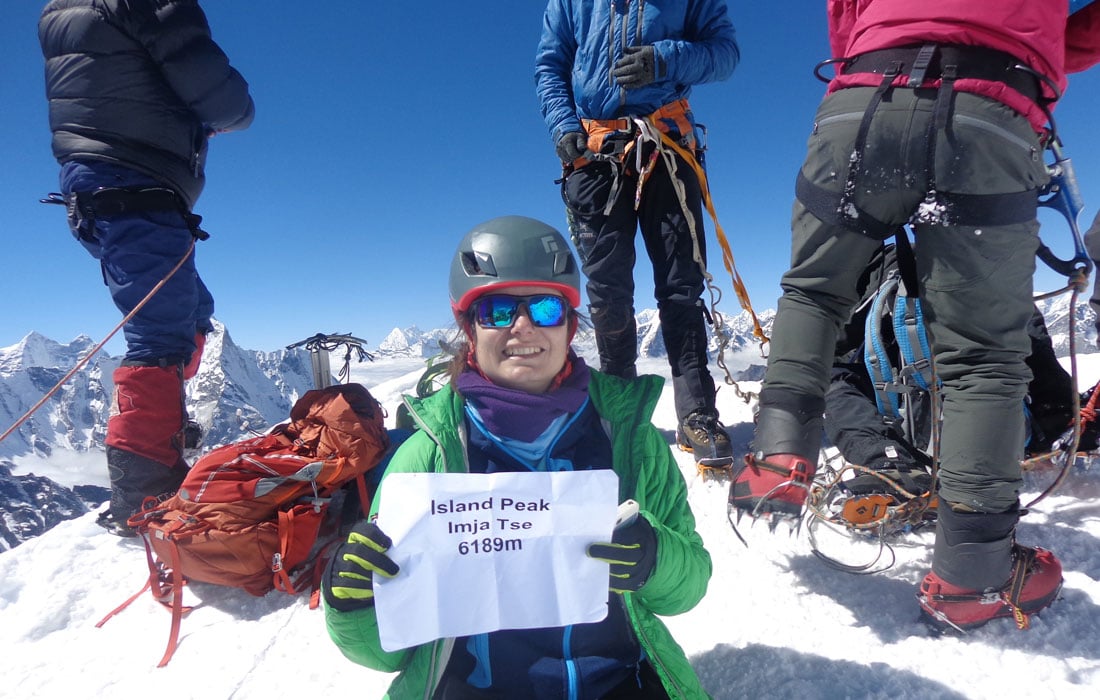

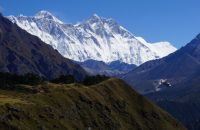
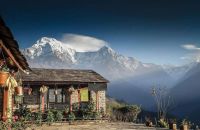
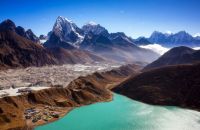
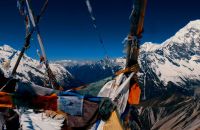
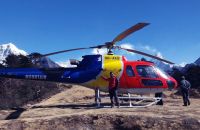
















Recent Comments
Yes it is possible to fly back in a helicopter if you do not want to walk down to Lukla. The helicopter flight back is only possible the next day of expedition since the weather of mountains are often cloudy and windy after mid day. You can either fly back to Lukla and continue with regular flight to Kathmandu or fly in helicopter all the way to Kathmandu.